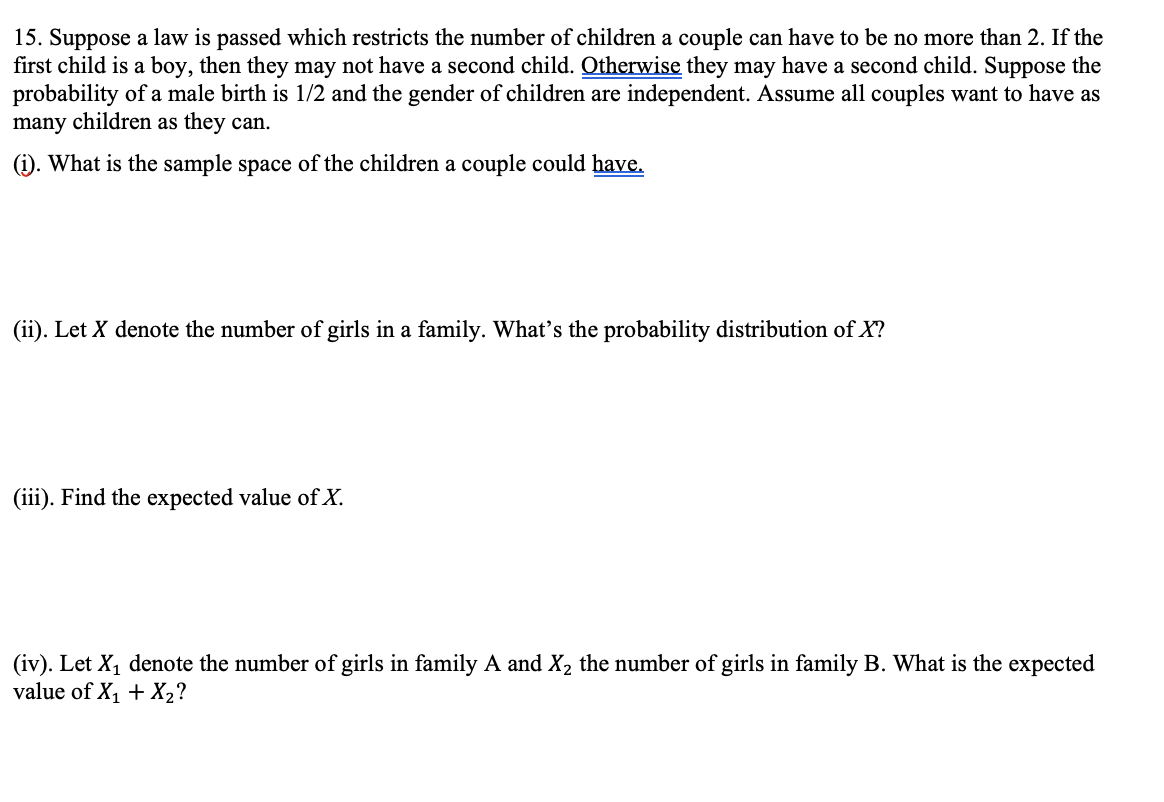15. Suppose a law is passed which restricts the number of children a couple can have to be no more than 2. If the first child is a boy, then they may not have a second child. Otherwise they may have a second child. Suppose the probability of a male birth is 1/2 and the gender of children are independent. Assume all couples want to have as many children as they can. (i). What is the sample space of the children a couple could have. (ii). Let X denote the number of girls in a family. What's the probability distribution of X?
15. Suppose a law is passed which restricts the number of children a couple can have to be no more than 2. If the first child is a boy, then they may not have a second child. Otherwise they may have a second child. Suppose the probability of a male birth is 1/2 and the gender of children are independent. Assume all couples want to have as many children as they can. (i). What is the sample space of the children a couple could have. (ii). Let X denote the number of girls in a family. What's the probability distribution of X?
Algebra & Trigonometry with Analytic Geometry
13th Edition
ISBN:9781133382119
Author:Swokowski
Publisher:Swokowski
Chapter10: Sequences, Series, And Probability
Section10.8: Probability
Problem 32E
Related questions
Question
For this practice, my teacher says the following answers are below. However, I don't know how he got these answers. Please explain.
i) S = {B, GB, GG}
ii) X 0 1 2
Probability 1/2 1/4 1/4
iii) ?? = ? × ?.? + ? × ?.?? + ? × ?.?? = .??
iv) ?? + ?? = ??? + ??? = ?.?? + ?.?? = ?.?

Transcribed Image Text:15. Suppose a law is passed which restricts the number of children a couple can have to be no more than 2. If the
first child is a boy, then they may not have a second child. Otherwise they may have a second child. Suppose the
probability of a male birth is 1/2 and the gender of children are independent. Assume all couples want to have as
many children as they can.
(i). What is the sample space of the children a couple could have.
(ii). Let X denote the number of girls in a family. What's the probability distribution of X?
(iii). Find the expected value of X.
(iv). Let X, denote the number of girls in family A and X2 the number of girls in family B. What is the expected
value of X1 + X2?
Expert Solution
This question has been solved!
Explore an expertly crafted, step-by-step solution for a thorough understanding of key concepts.
Step by step
Solved in 2 steps

Recommended textbooks for you

Algebra & Trigonometry with Analytic Geometry
Algebra
ISBN:
9781133382119
Author:
Swokowski
Publisher:
Cengage

Algebra & Trigonometry with Analytic Geometry
Algebra
ISBN:
9781133382119
Author:
Swokowski
Publisher:
Cengage